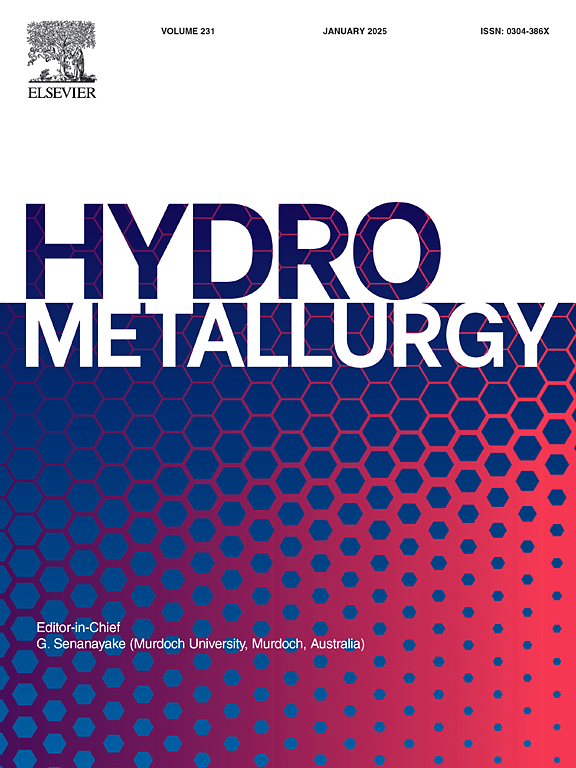Fundamentals of copper(II) adsorption on phyllosilicate minerals relevant to crud formation in solvent extraction from heap leach liquors
IF 4.8
2区 材料科学
Q1 METALLURGY & METALLURGICAL ENGINEERING
引用次数: 0
Abstract
Because of the common presence of different silicate minerals, like kaolinite, montmorillonite and muscovite as gangue minerals in the beneficiation of copper oxide ores, the interaction between copper(II) ions in solution and each of these minerals is a field of strong interest, considering their implications on the aggregation of these minerals in the extreme pH conditions typical of hydrometallurgical unit operations for copper production. After copper adsorption isotherms determination at pH 2 and 4, specific adsorption data were fitted to both Langmuir and Freundlich models. It was found that adsorption is systematically larger at pH 4, and that montmorillonite is the mineral that displays a larger adsorption capacity, as in principle expected by its larger cation exchange capacity, CEC. A good fitting to the Langmuir model was obtained for the three samples, and montmorillonite also appears to conform to Freundlich isotherm predictions, as the tested concentrations of copper(II) do not allow to reach saturation. Furthermore, some desorption is measured for kaolinite and muscovite at the highest copper concentrations, probably because of significant interactions between the adsorbed ions. No such desorption was detected in montmorillonite samples. An XPS analysis of the surfaces of the three minerals suggests that copper adsorption in kaolinite is not associated to a cation exchange process but rather to electrostatic interactions between silica-like faces of the clay. In contrast, ionic exchange of structural calcium (for montmorillonite) or potassium (in the case of muscovite) seems to be the predominant mechanism of Cu(II) adsorption in the other two samples. Electrophoretic mobility determinations agree with this hypothesis: the mobility (always negative, with no traces of charge inversion) decreases in absolute value when kaolinite particles are in contact with solutions of increasing copper concentration at pH 2 or pH 4. On the other hand, the electrophoretic mobility values of muscovite and montmorillonite showed a weak pH and copper concentration dependence, a result that matches well with the ion exchange processes detected in the XPS measurements.
从堆浸液中进行溶剂萃取时,植硅体矿物上与泥块形成有关的铜(II)吸附基本原理
由于在氧化铜矿石的选矿过程中普遍存在不同的硅酸盐矿物,如高岭石、蒙脱石和褐铁矿等煤矸石矿物,考虑到它们在铜生产的湿法冶金单元操作中典型的极端 pH 值条件下对这些矿物聚集的影响,溶液中的铜(II)离子与每种这些矿物之间的相互作用是一个非常值得关注的领域。在 pH 值为 2 和 4 的条件下测定铜吸附等温线后,特定的吸附数据与 Langmuir 和 Freundlich 模型进行了拟合。结果发现,pH 值为 4 时的吸附量较大,而蒙脱石是吸附量较大的矿物,这与蒙脱石较大的阳离子交换容量(CEC)是一致的。三种样品都与 Langmuir 模型有很好的拟合,蒙脱石似乎也符合 Freundlich 等温线的预测,因为测试的铜(II)浓度无法达到饱和。此外,在铜浓度最高的情况下,高岭石和麝香石也会出现一些解吸现象,这可能是由于吸附的离子之间存在明显的相互作用。蒙脱石样品中没有检测到这种解吸现象。对这三种矿物的表面进行的 XPS 分析表明,高岭石中的铜吸附与阳离子交换过程无关,而是与粘土中类似二氧化硅的表面之间的静电作用有关。相比之下,结构钙(蒙脱石)或钾(麝香石)的离子交换似乎是其他两种样品吸附铜(II)的主要机制。电泳迁移率的测定结果与这一假设一致:当高岭石颗粒在 pH 值为 2 或 4 时与铜浓度增加的溶液接触时,迁移率(始终为负值,没有电荷反转的痕迹)的绝对值会降低。 另一方面,麝香石和蒙脱石的电泳迁移率值对 pH 值和铜浓度的依赖性较弱,这一结果与 XPS 测量中检测到的离子交换过程非常吻合。
本文章由计算机程序翻译,如有差异,请以英文原文为准。
求助全文
约1分钟内获得全文
求助全文
来源期刊

Hydrometallurgy
工程技术-冶金工程
CiteScore
9.50
自引率
6.40%
发文量
144
审稿时长
3.4 months
期刊介绍:
Hydrometallurgy aims to compile studies on novel processes, process design, chemistry, modelling, control, economics and interfaces between unit operations, and to provide a forum for discussions on case histories and operational difficulties.
Topics covered include: leaching of metal values by chemical reagents or bacterial action at ambient or elevated pressures and temperatures; separation of solids from leach liquors; removal of impurities and recovery of metal values by precipitation, ion exchange, solvent extraction, gaseous reduction, cementation, electro-winning and electro-refining; pre-treatment of ores by roasting or chemical treatments such as halogenation or reduction; recycling of reagents and treatment of effluents.
 求助内容:
求助内容: 应助结果提醒方式:
应助结果提醒方式:


